Alkaline Treatment Variables to Characterize Poly(Vinyl Alcohol)/Poly(Vinyl Butyral/Vinyl Alcohol) Blend Films
Abstract
:1. Introduction
2. Materials and Methods
2.1. Materials
2.2. Preparation of PVAc
2.3. Preparation of PVAc/PVB Blend Films and Heterogeneous Saponified PVA/P(VB-VA) Films
2.4. Mechanical Properties of Films
2.5. Surface Characterization of Films
2.6. Characteristics of Prepared Films
3. Results and Discussion
3.1. Optical Microscopy
3.2. FTIR Spectroscopy
3.3. XRD Analysis
3.4. 1H-NMR Spectroscopy
3.5. Thermal Analysis
3.6. Mechanical Properties
3.7. Contact Angle Measurements
4. Conclusions
Author Contributions
Funding
Institutional Review Board Statement
Informed Consent Statement
Conflicts of Interest
References
- Di Landro, L.; Capone, C.; Inzoli, F.; Malacari, P.E. Coextruded PVC tubes for biomedical application. J. Vinyl Addit. Technol. 2005, 11, 111–118. [Google Scholar] [CrossRef]
- Taha, T. Optical properties of PVC/Al2O3 nanocomposite films. Polym. Bull. 2019, 76, 903–918. [Google Scholar] [CrossRef]
- Ahmed, R. Optical study on poly (methyl methacrylate)/poly (vinyl acetate) blends. Int. J. Photoenergy 2009, 2009, 150389. [Google Scholar] [CrossRef]
- Nouh, S.; Benthami, K.; Abou Elfadl, A.; El-Nabarawy, H.A. Modification induced by gamma irradiation in polystyrene/poly (methyl methacrylate) blends. Int. Polym. Processing 2017, 32, 253–259. [Google Scholar] [CrossRef]
- Ahmad, J.; Hågg, M.B. Polyvinyl acetate/titanium dioxide nanocomposite membranes for gas separation. J. Membr. Sci. 2013, 445, 200–210. [Google Scholar] [CrossRef]
- Botros, S.; Kenawy, M.; Younan, A.; El Kashef, I. Thermal stability, swelling behaviour and dielectric properties of NBR/PVC-PVAc blends. Kautsch. Gummi Kunstst. 2000, 53, 722–729. [Google Scholar]
- McKeen, L.W. Permeability Properties of Plastics and Elastomers; William Andrew: Norwich, NY, USA, 2016. [Google Scholar]
- Haraya, K.; Hwang, S.-T. Permeation of oxygen, argon and nitrogen through polymer membranes. J. Membr. Sci. 1992, 71, 13–27. [Google Scholar] [CrossRef]
- Liu, G.-S.; Yan, X.; Yan, F.-F.; Chen, F.-X.; Hao, L.-Y.; Chen, S.-J.; Lou, T.; Ning, X.; Long, Y.-Z. In situ electrospinning iodine-based fibrous meshes for antibacterial wound dressing. Nanoscale Res. Lett. 2018, 13, 309. [Google Scholar] [CrossRef]
- Xu, H.; Li, H.; Chang, J. Controlled drug release from a polymer matrix by patterned electrospun nanofibers with controllable hydrophobicity. J. Mater. Chem. B 2013, 1, 4182–4188. [Google Scholar] [CrossRef]
- Liu, M.N.; Yan, X.; You, M.H.; Fu, J.; Nie, G.D.; Yu, M.; Ning, X.; Wan, Y.; Long, Y.Z. Reversible photochromic nanofibrous membranes with excellent water/windproof and breathable performance. J. Appl. Polym. Sci. 2018, 135, 46342. [Google Scholar] [CrossRef]
- Yan, X.; You, M.-H.; Lou, T.; Yu, M.; Zhang, J.-C.; Gong, M.-G.; Lv, F.-Y.; Huang, Y.-Y.; Long, Y.-Z. Colorful hydrophobic poly (vinyl butyral)/cationic dye fibrous membranes via a colored solution electrospinning process. Nanoscale Res. Lett. 2016, 11, 540. [Google Scholar] [CrossRef] [PubMed] [Green Version]
- Wu, H.; Zhang, R.; Sun, Y.; Lin, D.; Sun, Z.; Pan, W.; Downs, P. Biomimetic nanofiber patterns with controlled wettability. Soft Matter 2008, 4, 2429–2433. [Google Scholar] [CrossRef]
- Chen, S.; Liu, G.-S.; He, H.-W.; Zhou, C.-F.; Yan, X.; Zhang, J.-C. Physical structure induced hydrophobicity analyzed from electrospinning and coating polyvinyl butyral films. Adv. Condens. Matter Phys. 2019, 2019, 6179456. [Google Scholar] [CrossRef]
- Baskaran, R.; Selvasekarapandian, S.; Kuwata, N.; Kawamura, J.; Hattori, T. Structure, thermal and transport properties of PVAc–LiClO4 solid polymer electrolytes. J. Phys. Chem. Solids 2007, 68, 407–412. [Google Scholar] [CrossRef]
- Veerabhadraiah, A.; Ramakrishna, S.; Angadi, G.; Venkatram, M.; Kanivebagilu Ananthapadmanabha, V.; Hebbale NarayanaRao, N.M.; Munishamaiah, K. Development of polyvinyl acetate thin films by electrospinning for sensor applications. Appl. Nanosci. 2017, 7, 355–363. [Google Scholar] [CrossRef]
- Petković, G.; Vukoje, M.; Bota, J.; Pasanec Preprotić, S. Enhancement of Polyvinyl Acetate (PVAc) Adhesion Performance by SiO2 and TiO2 Nanoparticles. Coatings 2019, 9, 707. [Google Scholar] [CrossRef]
- Park, K.R.; Nho, Y.C. Preparation and characterization by radiation of hydrogels of PVA and PVP containing Aloe vera. J. Appl. Polym. Sci. 2004, 91, 1612–1618. [Google Scholar] [CrossRef]
- Andersen, F. Amended final safety assessment of polyvinyl acetate. J. Am. Coll. Toxicol. 1996, 15, 166–176. [Google Scholar]
- Yang, S.B.; Park, S.M.; Kwon, D.J.; Shin, J.-C.; Sabina, Y.; Yeum, J.H. Novel Poly (vinyl alcohol)/Clay Nanocomposite Film Prepared by the Heterogeneous Saponification of Poly (vinyl acetate)/Clay Nanocomposite Film. Sci. Adv. Mater. 2020, 12, 319–325. [Google Scholar] [CrossRef]
- Lee, S.G.; Kim, J.P.; Lyoo, W.S.; Kwak, J.W.; Noh, S.K.; Park, C.S.; Kim, J.H. Preparation of novel syndiotactic poly (vinyl alcohol) microspheres through the low-temperature suspension copolymerization of vinyl pivalate and vinyl acetate and heterogeneous saponification. J. Appl. Polym. Sci. 2005, 95, 1539–1548. [Google Scholar] [CrossRef]
- Jung, H.M.; Lee, E.M.; Ji, B.C.; Deng, Y.; Yun, J.D.; Yeum, J.H. Poly (vinyl acetate)/poly (vinyl alcohol)/montmorillonite nanocomposite microspheres prepared by suspension polymerization and saponification. Colloid Polym. Sci. 2007, 285, 705–710. [Google Scholar] [CrossRef]
- Kwon, I.J.; Park, S.M.; Jeong, M.G.; Yang, S.B.; Yoo, S.H.; Jeong, D.W.; Sabina, Y.; Oh, W.; Choi, H.; Yeum, J.H. Novel Poly (vinyl alcohol)/Carbon Nanotube Nanocomposite Microspheres Prepared via Suspension Polymerization and Saponification. J. Nanosci. Nanotechnol. 2016, 16, 12028–12033. [Google Scholar] [CrossRef]
- Yang, S.B.; Lee, H.J.; Sabina, Y.; Kim, J.W.; Yeum, J.H. Novel poly (vinyl alcohol) nanofibers prepared by heterogeneous saponification of electrospun poly (vinyl acetate). Colloids Surf. A 2016, 497, 265–270. [Google Scholar] [CrossRef]
- Yang, S.B.; Yoo, S.H.; Lee, J.S.; Kim, J.W.; Yeum, J.H. Surface properties of a novel poly (vinyl alcohol) film prepared by heterogeneous saponification of poly (vinyl acetate) film. Polymers 2017, 9, 493. [Google Scholar] [CrossRef]
- Georgieva, N.; Bryaskova, R.; Tzoneva, R. New Polyvinyl alcohol-based hybrid materials for biomedical application. Mater. Lett. 2012, 88, 19–22. [Google Scholar] [CrossRef]
- Sulaiman, N.; Ghazali, M.; Majlis, B.; Yunas, J.; Razali, M. Influence of Polyvinylalcohol on the Size of Calcium Ferrite Nanoparticles Synthesized Using a Sol-gel Technique. In Proceedings of the International Conference for Innovation in Biomedical Engineering and Life Sciences, Putrajaya, Malaysia, 6–8 December 2015; Springer: Berlin/Heidelberg, Germany, 2015; pp. 198–202. [Google Scholar]
- Chen, X.; Taguchi, T. Hydrophobically modified poly (vinyl alcohol) s as antithrombogenic coating materials. Mater. Sci. Eng. C 2019, 102, 289–298. [Google Scholar] [CrossRef]
- Chaouat, M.; Le Visage, C.; Baille, W.E.; Escoubet, B.; Chaubet, F.; Mateescu, M.A.; Letourneur, D. A novel cross-linked poly (vinyl alcohol)(PVA) for vascular grafts. Adv. Funct. Mater. 2008, 18, 2855–2861. [Google Scholar] [CrossRef]
- Miyamoto, A.; Lee, S.; Cooray, N.F.; Lee, S.; Mori, M.; Matsuhisa, N.; Jin, H.; Yoda, L.; Yokota, T.; Itoh, A. Inflammation-free, gas-permeable, lightweight, stretchable on-skin electronics with nanomeshes. Nat. Nanotechnol. 2017, 12, 907–913. [Google Scholar] [CrossRef]
- Li, H.-Z.; Chen, S.-C.; Wang, Y.-Z. Thermoplastic PVA/PLA Blends with Improved Processability and Hydrophobicity. Ind. Eng. Chem. Res. 2014, 53, 17355–17361. [Google Scholar] [CrossRef]
- Huang, Y.; Zhao, H.; Chen, S.; Wan, G.; Miao, D. Preparation of multifunctional wound dressings with composite PVA/PE films. J. Mater. Sci. 2022, 57, 2115–2130. [Google Scholar] [CrossRef]
- Yang, S.B.; Jeong, D.W.; Lee, J.; Yeasmin, S.; Kim, C.-K.; Yeum, J.H. Preparation of the Heterogeneous Saponified Poly (Vinyl Alcohol)/Poly (Methyl Methacrylate–Methallyl Alcohol) Blend Film. Materials 2022, 15, 2439. [Google Scholar] [CrossRef] [PubMed]
- Li, M.; Li, J.; Zhou, M.; Xian, Y.; Shui, Y.; Wu, M.; Yao, Y. Super-hydrophilic electrospun PVDF/PVA-blended nanofiber membrane for microfiltration with ultrahigh water flux. J. Appl. Polym. Sci. 2020, 137, 48416. [Google Scholar] [CrossRef]
- Sun, K.; Xia, Y.; Ouyang, J. Improvement in the photovoltaic efficiency of polymer solar cells by treating the poly (3, 4-ethylenedioxythiophene): Poly (styrenesulfonate) buffer layer with co-solvents of hydrophilic organic solvents and hydrophobic 1, 2-dichlorobenzene. Sol. Energy Mater. Sol. Cells 2012, 97, 89–96. [Google Scholar] [CrossRef]
- Osorio, M.; Velásquez-Cock, J.; Restrepo, L.M.; Zuluaga, R.; Gañán, P.; Rojas, O.J.; Ortiz-Trujillo, I.; Castro, C. Bioactive 3D-shaped wound dressings synthesized from bacterial cellulose: Effect on cell adhesion of polyvinyl alcohol integrated in situ. Int. J. Polym. Sci. 2017, 2017, 3728485. [Google Scholar] [CrossRef]
- Chen, X.; Taguchi, T. Enhanced skin adhesive property of hydrophobically modified poly (vinyl alcohol) films. ACS Omega 2020, 5, 1519–1527. [Google Scholar] [CrossRef]
- Gao, T.; Jiang, M.; Liu, X.; You, G.; Wang, W.; Sun, Z.; Ma, A.; Chen, J. Patterned Polyvinyl Alcohol Hydrogel Dressings with Stem Cells Seeded for Wound Healing. Polymers 2019, 11, 171. [Google Scholar] [CrossRef]
- Van Ngo, H.; Nguyen, P.K.; Van Vo, T.; Duan, W.; Tran, V.-T.; Tran, P.H.-L.; Tran, T.T.-D. Hydrophilic-hydrophobic polymer blend for modulation of crystalline changes and molecular interactions in solid dispersion. Int. J. Pharm. 2016, 513, 148–152. [Google Scholar] [CrossRef]
- Pearce, A.K.; O’Reilly, R.K. Polymers for biomedical applications: The importance of hydrophobicity in directing biological interactions and application efficacy. Biomacromolecules 2021, 22, 4459–4469. [Google Scholar] [CrossRef]
- Zhang, Y.; Yuan, Z.-P.; Qin, Y.; Dai, J.; Zhang, T. Comparative studies on hydrophilic and hydrophobic segments grafted poly (vinyl chloride). Chin. J. Polym. Sci. 2018, 36, 604–611. [Google Scholar] [CrossRef]
- Sana, S.S.; Badineni, V.R.; Arla, S.K.; Boya, V.K.N. Hydrophilic–hydrophobic polymer based blend membrane for separation of water–isopropanol mixtures by pervaporation. SN Appl. Sci. 2020, 2, 1848. [Google Scholar] [CrossRef]
- Ding, J.; Chen, S.-C.; Wang, X.-L.; Wang, Y.-Z. Synthesis and properties of thermoplastic poly (vinyl alcohol)-graft-lactic acid copolymers. Ind. Eng. Chem. Res. 2009, 48, 788–793. [Google Scholar] [CrossRef]
- Tupý, M.; Měřínská, D.; Svoboda, P.; Kalendová, A.; Klásek, A.; Zvoníček, J. Effect of water and acid–base reactants on adhesive properties of various plasticized poly(vinyl butyral) sheets. J. Appl. Polym. Sci. 2013, 127, 3474–3484. [Google Scholar] [CrossRef]
- Chiulan, I.; Frone, A.N.; Panaitescu, D.M.; Nicolae, C.A.; Trusca, R. Surface properties, thermal, and mechanical characteristics of poly(vinyl alcohol)–starch-bacterial cellulose composite films. J. Appl. Polym. Sci. 2018, 135, 45800. [Google Scholar] [CrossRef]
- Yeasmin, S.; Yeum, J.H.; Yang, S.B. Fabrication and characterization of pullulan-based nanocomposites reinforced with montmorillonite and tempo cellulose nanofibril. Carbohyd. Polym. 2020, 240, 116307. [Google Scholar] [CrossRef] [PubMed]
- Musa, B.H.; Hameed, N.J. Study of the mechanical properties of polyvinyl alcohol/starch blends. Mater. Today 2020, 20, 439–442. [Google Scholar] [CrossRef]
- Karger-Kocsis, J.; Fakirov, S. Nano- and Micromechanics of Polymer Blends and Composites; Hanser Publications: Cincinnati, OH, USA, 2009. [Google Scholar] [CrossRef]
- Triyana, K.; Rianjanu, A.; Nugroho, D.B.; As’ari, A.H.; Kusumaatmaja, A.; Roto, R.; Suryana, R.; Wasisto, H.S. A highly sensitive safrole sensor based on polyvinyl acetate (PVAc) nanofiber-coated QCM. Sci. Rep. 2019, 9, 15407. [Google Scholar] [CrossRef]
- Muroga, S.; Takahashi, Y.; Hikima, Y.; Ata, S.; Ohshima, M.; Okazaki, T.; Hata, K. New evaluation method for the curing degree of rubber and its nanocomposites using ATR-FTIR spectroscopy. Polym. Test. 2021, 93, 106993. [Google Scholar] [CrossRef]
- Yang, S.B.; Kim, J.W.; Yeum, J.H. Effect of Saponification Condition on the Morphology and Diameter of the Electrospun Poly(vinyl acetate) Nanofibers for the Fabrication of Poly(vinyl alcohol) Nanofiber Mats. Polymers 2016, 8, 376. [Google Scholar] [CrossRef]
- Abdelghany, A.M.; Meikhail, M.S.; Asker, N. Synthesis and structural-biological correlation of PVC\PVAc polymer blends. J. Mater. Res. Technol. 2019, 8, 3908–3916. [Google Scholar] [CrossRef]
- Liao, G.-M.; Yang, C.-C.; Hu, C.-C.; Pai, Y.-L.; Lue, S.J. Novel quaternized polyvinyl alcohol/quaternized chitosan nano-composite as an effective hydroxide-conducting electrolyte. J. Membr. Sci. 2015, 485, 17–29. [Google Scholar] [CrossRef]
- Aruldass, S.; Mathivanan, V.; Mohamed, A.R.; Tye, C.T. Factors affecting hydrolysis of polyvinyl acetate to polyvinyl alcohol. J. Environ. Chem. Eng. 2019, 7, 103238. [Google Scholar] [CrossRef]
- Qin, X.-X.; Cheng, Z.-L. Application of ionic liquids as a catalyst in the synthesis of polyvinyl butyral (PVB) polymer. Chin. Chem. Lett. 2016, 27, 145–148. [Google Scholar] [CrossRef]
- Devangamath, S.S.; Lobo, B.; Masti, S.P.; Narasagoudr, S. Correction to: Thermal, mechanical, and AC electrical studies of PVA–PEG–Ag2S polymer hybrid material. J. Mater. Sci. Mater. Electron. 2021, 32, 14115–14116. [Google Scholar] [CrossRef]
- Aziz, S.B.; Abdulwahid, R.T.; Rasheed, M.A.; Abdullah, O.G.; Ahmed, H.M. Polymer Blending as a Novel Approach for Tuning the SPR Peaks of Silver Nanoparticles. Polymers 2017, 9, 486. [Google Scholar] [CrossRef] [PubMed]
- Čech Barabaszová, K.; Holešová, S.; Bílý, M.; Hundáková, M. CuO and CuO/Vermiculite Based Nanoparticles in Antibacterial PVAc Nanocomposites. J. Inorg. Organomet. Polym. Mater. 2020, 30, 4218–4227. [Google Scholar] [CrossRef]
- Peer, P.; Polaskova, M.; Musilova, L. Superhydrophobic poly(vinyl butyral) nanofibrous membrane containing various silica nanoparticles. J. Text. Inst. 2019, 110, 1508–1514. [Google Scholar] [CrossRef]
- Salam, A.; Khan, M.Q.; Hassan, T.; Hassan, N.; Nazir, A.; Hussain, T.; Azeem, M.; Kim, I.S. In-vitro assessment of appropriate hydrophilic scaffolds by co-electrospinning of poly(1,4 cyclohexane isosorbide terephthalate)/polyvinyl alcohol. Sci. Rep. 2020, 10, 19751. [Google Scholar] [CrossRef]
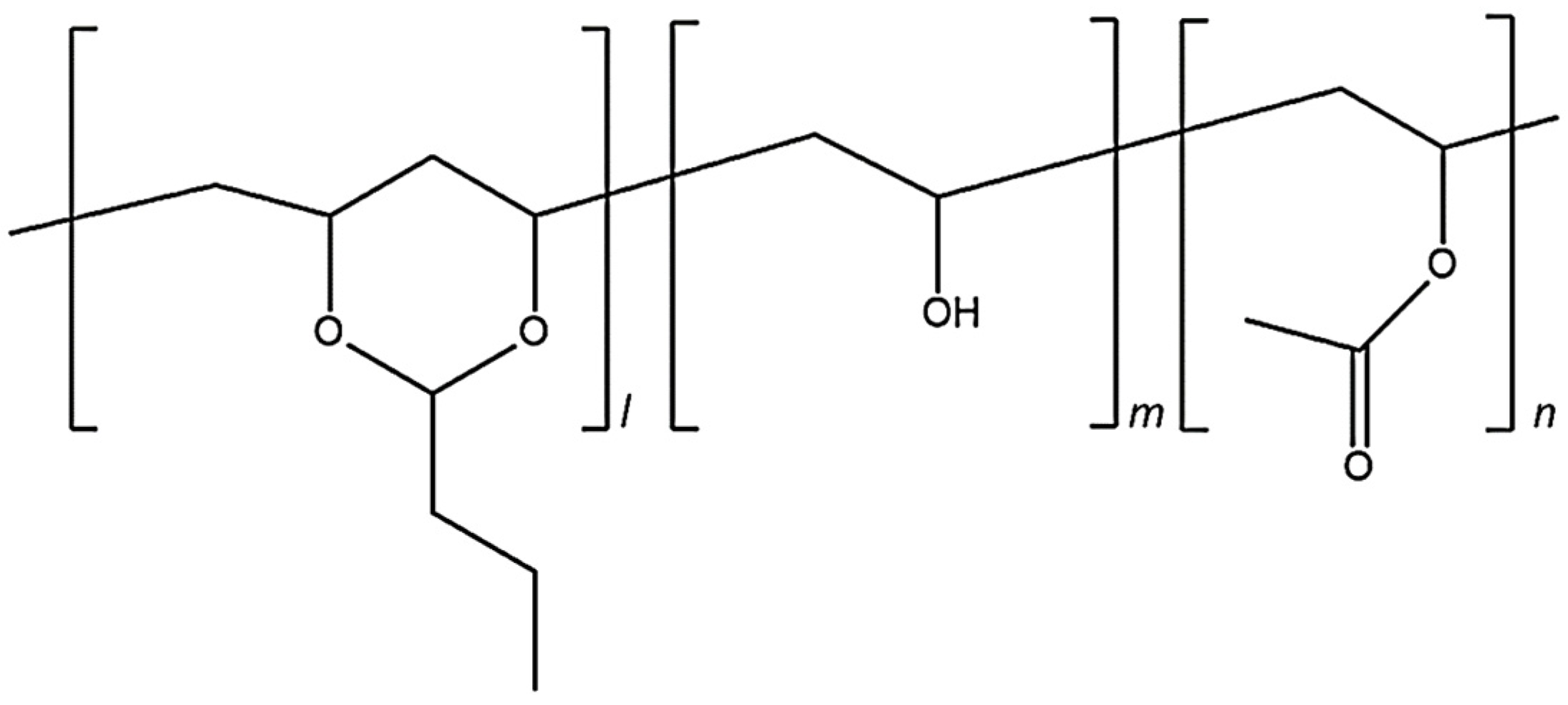
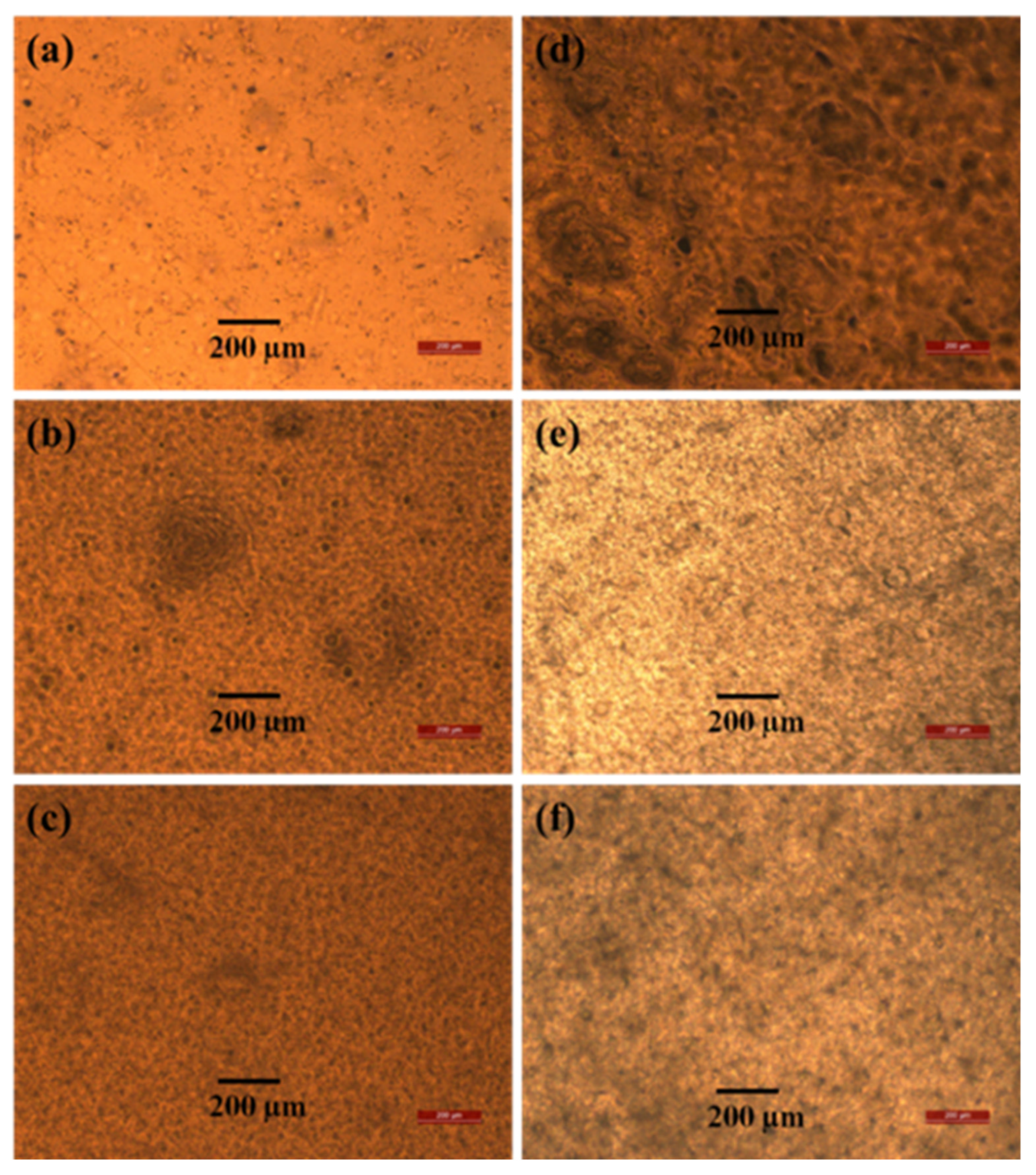
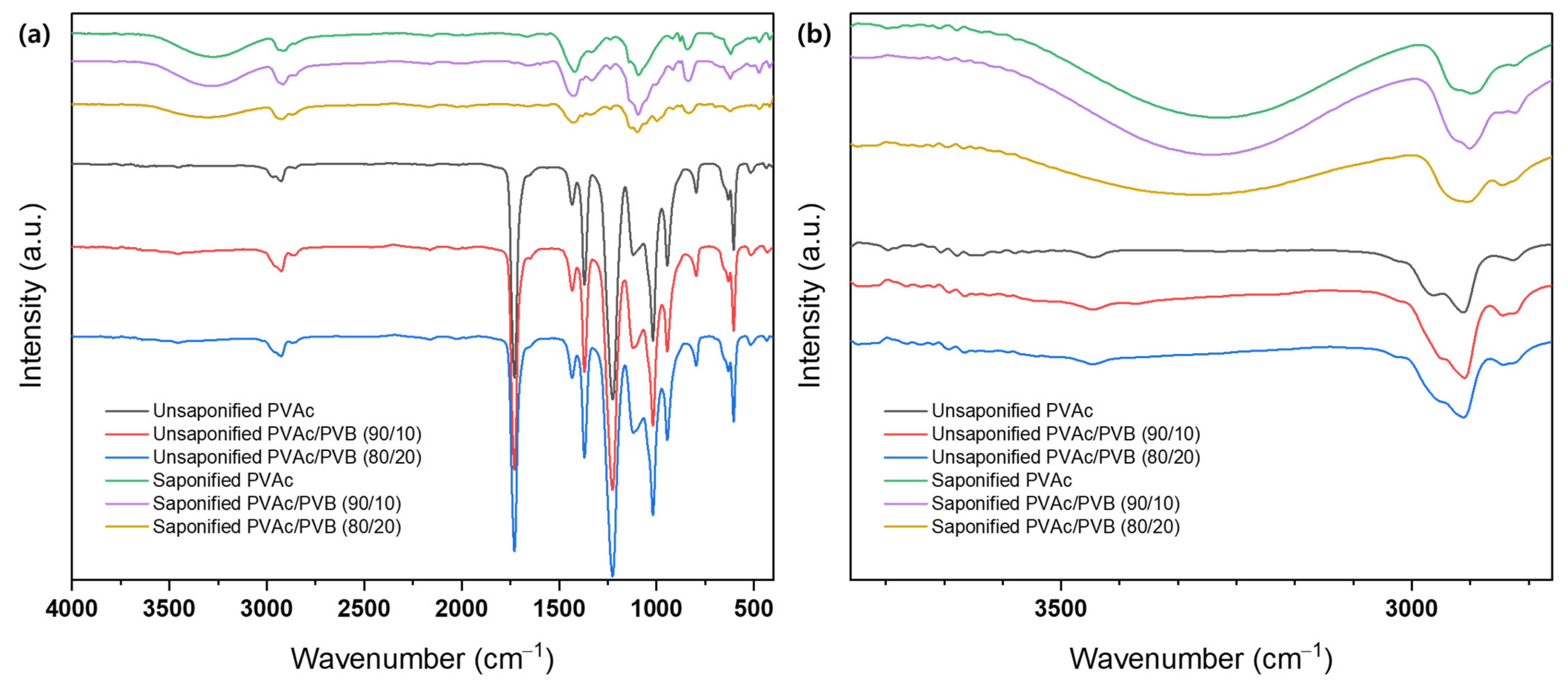
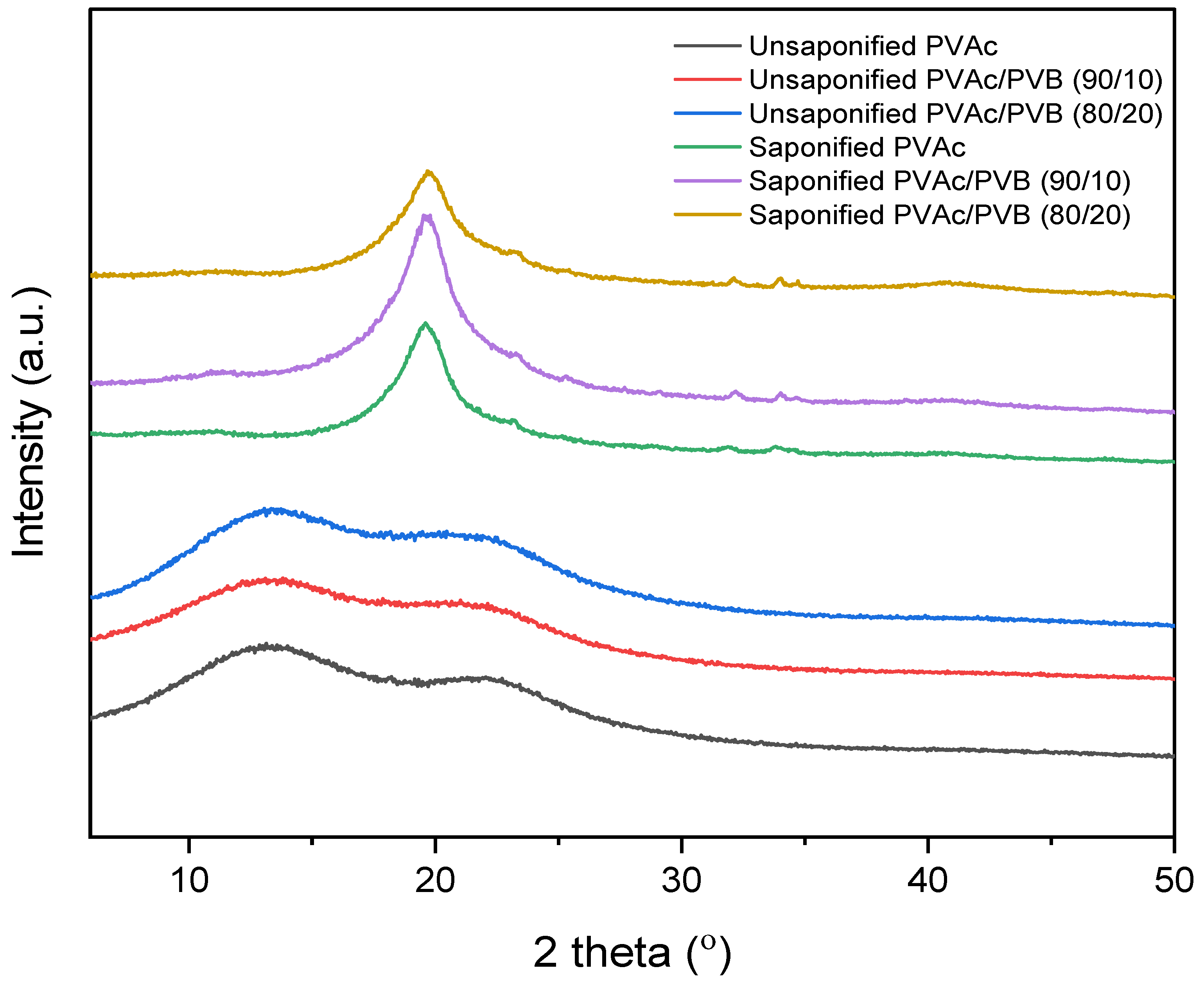



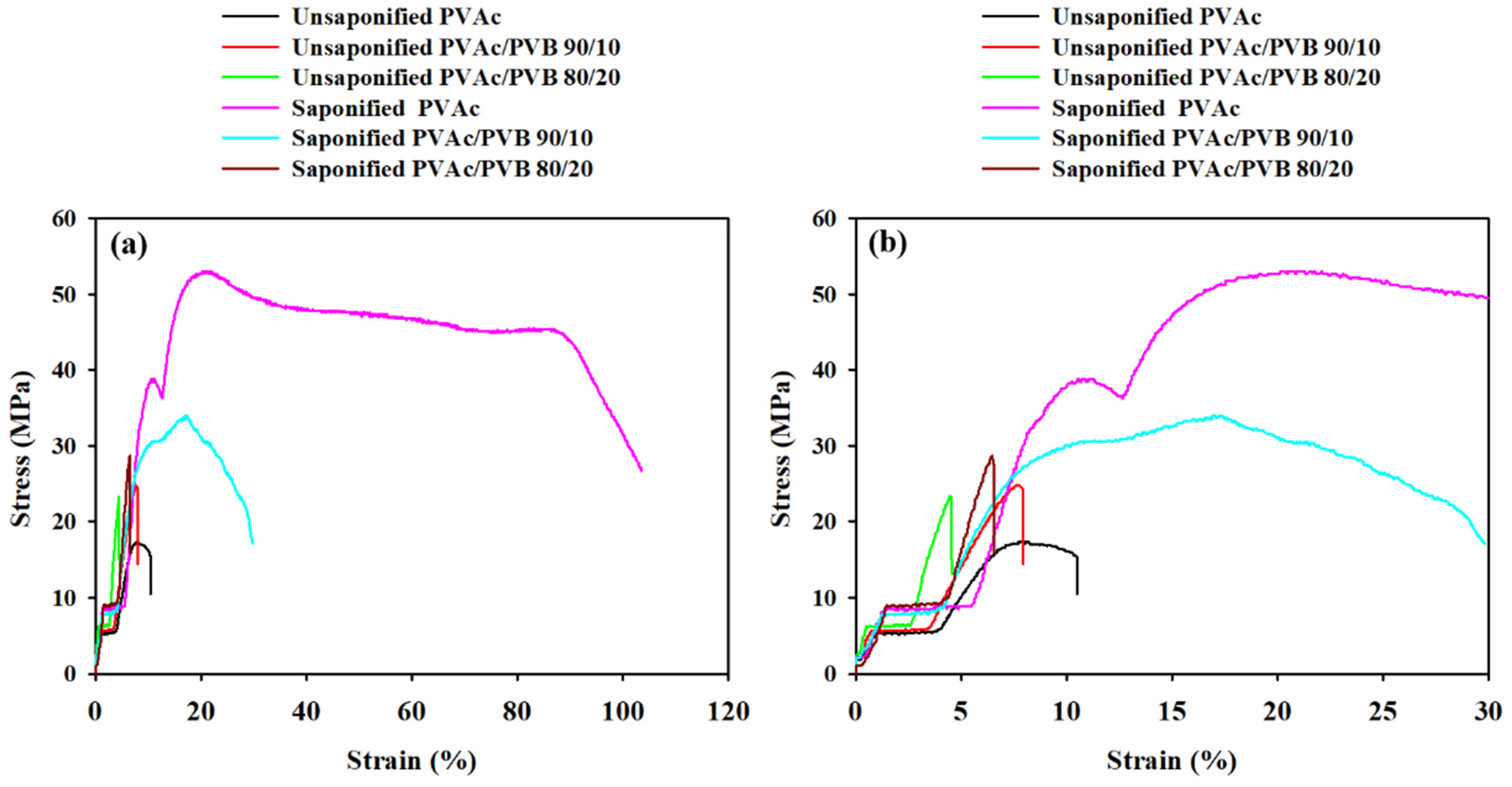
| Film Sample | Thickness (μm) | Weight (g) |
|---|---|---|
| Pure PVAc | 140 ± 6 | 0.12 ± 0.08 |
| Saponified Pure PVAc | 150.4 ± 9.34 | 0.08 ± 0.10 |
| PVAc/PVB 90/10 | 160 ± 5.09 | 0.12 ± 0.11 |
| Saponified PVAc/PVB 90/10 | 213.2 ± 5.31 | 0.07 ± 0.10 |
| PVAc/PVB 80/20 | 168 ± 5.83 | 0.18 ± 0.13 |
| Saponified PVAc/PVB 80/20 | 230 ± 8.83 | 0.11 ± 0.10 |
| Film Sample | 24 h | 48 h | 72 h | 96 h |
|---|---|---|---|---|
| PVAc | 81.98% | 99.9% | 99.9% | 99.99% |
| PVAc/PVB 90/10 | 80.73% | 99.9% | 99.9% | 99.99% |
| PVAc/PVB 80/20 | 50.24% | 98.99% | 99.99% | 99.99% |
| Film Sample | Char Yields (%) | T3% (°C) | T10% (°C) | Tmax (°C) | WLRmax (% min−1) |
|---|---|---|---|---|---|
| PVAc | 6.09 | 273.43 | 296.85 | 315.78 | 2.05 |
| Saponified PVAc | 12.09 | 122.98 | 219.45 | 234.03 | 1.54 |
| PVAc/PVB 90/10 | 5.04 | 265.31 | 295.79 | 314.81 | 1.86 |
| Saponified PVAc/PVB 90/10 | 12.09 | 139.48 | 220.80 | 233.48 | 1.09 |
| PVAc/PVB 80/20 | 6.43 | 271.65 | 298.35 | 317.81 | 1.87 |
| Saponified PVAc/PVB 80/20 | 12.09 | 134.48 | 222.15 | 234.83 | 1.06 |
| Film Sample | Breaking Stress (MPa) | Breaking Strain (%) |
|---|---|---|
| PVAc | 15.29 ± 0.13 | 10.63 ± 0.20 |
| Saponified PVAc | 45.53 ± 0.25 | 86.32 ± 8.60 |
| PVAc/PVB 90/10 | 24.72 ± 0.15 | 7.58 ± 0.17 |
| Saponified PVAc/PVB 90/10 | 33.98 ± 0.19 | 16.99 ± 0.23 |
| PVAc/PVB 80/20 | 23.40 ± 0.13 | 4.29 ± 0.19 |
| Saponified PVAc/PVB 80/20 | 28.61 ± 0.16 | 6.31 ± 0.17 |
| Unsaponified Film | Contact Angle (°) | Saponified Film | Contact Angle (°) |
|---|---|---|---|
| PVAc | 57.68 | PVAc | 27.41 |
| PVAc/PVB 90/10 | 70.54 | PVAc/PVB 90/10 | 39.03 |
| PVAc/PVB 80/20 | 76.54 | PVAc/PVB 80/20 | 49.14 |
| PVB | 69.19 | - | - |
Publisher’s Note: MDPI stays neutral with regard to jurisdictional claims in published maps and institutional affiliations. |
© 2022 by the authors. Licensee MDPI, Basel, Switzerland. This article is an open access article distributed under the terms and conditions of the Creative Commons Attribution (CC BY) license (https://creativecommons.org/licenses/by/4.0/).
Share and Cite
Yang, S.B.; Karim, M.R.; Lee, J.; Yeum, J.H.; Yeasmin, S. Alkaline Treatment Variables to Characterize Poly(Vinyl Alcohol)/Poly(Vinyl Butyral/Vinyl Alcohol) Blend Films. Polymers 2022, 14, 3916. https://doi.org/10.3390/polym14183916
Yang SB, Karim MR, Lee J, Yeum JH, Yeasmin S. Alkaline Treatment Variables to Characterize Poly(Vinyl Alcohol)/Poly(Vinyl Butyral/Vinyl Alcohol) Blend Films. Polymers. 2022; 14(18):3916. https://doi.org/10.3390/polym14183916
Chicago/Turabian StyleYang, Seong Baek, Mohammad Rezaul Karim, Jungeon Lee, Jeong Hyun Yeum, and Sabina Yeasmin. 2022. "Alkaline Treatment Variables to Characterize Poly(Vinyl Alcohol)/Poly(Vinyl Butyral/Vinyl Alcohol) Blend Films" Polymers 14, no. 18: 3916. https://doi.org/10.3390/polym14183916







